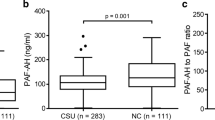Abstract
Data gathered prove that circulating platelets are activated upon human allergic inflammation, partly as a result of direct IgE-mediated process. It has been indicated that platelets may contribute to pathogenesis of atopic eczema/dermatitis syndrome (AEDS). Authors of the recent study have investigated systemic platelet activation in patients with AEDS on the basis of blood level of beta-thromboglobulin (beta-TG) and platelet factor 4 (PF4), which are recognized markers of platelet activation, also belonging to C-X-C chemokine family. Plasma levels of beta-TG and PF4 were measured by enzyme-linked immunoassay (ELISA) in 18 AEDS patients with moderate disease activity and 23 healthy, nonatopic individuals. No differences in peripheral platelet count of the two groups were noted. Only four (33.3%) AEDS patients represented beta-TG and PF4 within the control range; plasma beta-TG and PF4 were significantly increased (p < 0.001) in the AEDS group compared as a whole with the control subjects. No association between circulating concentrations of beta-TG or PF4 and total IgE levels in AEDS patients was proved. The results suggest that some patients with AEDS may have enhanced blood platelet activity as expressed by beta-TG and PF4 level.
Similar content being viewed by others
References
Capron, A., J. C. Ameisen, M. Joseph, C. Auriault, A. B. Tonnel, and J. Caen. 1985. New functions for platelets and their pathological implications. Int. Arch. Allergy Appl. Immunol. 77:107–114.
Cines, D. B., H. van der Keyl, and A. I. Levinson. 1986. In vitro binding of an IgE protein to human platelets. J. Immunol. 139:3433–3436.
Orchard, M. A., A. Kagey-Sobotka, D. Proud, and L. M. Lichtenstein. 1986. Basophil histamine release induced by a substance from stimulated human platelets. J. Immunol. 136:2240–2244.
Hayashi, N., J. Chihara, Y. Kobayashi, T. Kakazu, D. Kurachi, T. Yamamoto, and S. Nakajima. 1994. Effect of platelet-activating factor and platelet factor 4 on eosinophil adhesion. Int. Arch. Allergy Immunol. 104(Suppl):57–59.
Burgers, J. A., R. C. Schweizer, L. Koenderman, P. L. Bruijnzeel, and J. W. Akkerman. 1993. Human platelets secrete chemotactic activity for eosinophils. Blood 81:49–55.
Kaplan, K. L., and J. Owen. 1981. Plasma levels of β-thromboglobulin and platelet factor 4 as indices of platelet activation in vivo. Blood 57:199–202.
Watanabe, O., K. Natori, M. Tamari, Y. Shiomoto, S. Kubo, and Y. Nakamura. 1999. Significantly elevated expression of PF4 (platelet factor 4) and eotaxin in the NOA mouse, a model for atopic dermatitis. J. Hum. Genet. 44:173–176.
Kasperska-Zajac, A., B. Rogala, M. Nowakowski. 2003. Enhanced release of platelet factor 4 into the circulation in patients with the atopic eczema/dermatitis syndrome. Ann. Acad. Med. Bialostocensis. 48:128–130.
Hanifin, J., and G. Rajka. 1980. Diagnostic features of atopic dermatitis. Acta. Derm. Venereol. (Stockh.). 92(Suppl):44–47.
Rajka, G., and T. Lageland. 1989. Grading of the severity of atopic dermatitis. Acta Derm. Venereol. (Stockh.). 144(Suppl):13–14.
Kurihara, Y., H. Nakayama, and S. Nakagawa. 1980. Plasma beta-thromboglobulin and platelet factor 4 in renal insufficiency. Thromb. Res. 18:557–560.
Szczeklik, A., P. C. Milner, J. Birch, J. Watkins, and J. F. Martin. 1986. Prolonged bleeding time, reduced platelet aggregation, altered PAF-acether sensitivity and increased platelet mass are a trait of asthma and hay fever. Thromb. Haemost. 56:283–287.
Gallagher, J. S., I. L. Bernstein, C. A. Maccia, G. L. Splansky, and H. I. Glueck. 1978. Cyclic platelet dysfunction in IgE-mediated allergy. J. Allergy Clin. Immunol. 62:229–235.
Rogala, B., J. Gumprecht, R. Gawlik, and K. Strojek. 1995. Platelet aggregation in IgE-mediated allergy with elevated soluble FcɛRII/CD23 level. J. Invest. Allergol. Clin. Immunol. 5:161–165.
Pitchford, S. C., H. Yano, R. Lever, Y. Riffo-Vasquez, S. Ciferri, M. J. Rose, S. Giannini, S. Momi, D. Spina, B. O’Connor, P. Gresele, and C. P. Page. 2003. Platelets are essential for leukocyte recruitment in allergic inflammation. J. Allergy Clin. Immunol. 112:109–118.
Rogala, B., J. Gumprecht, and J. Glück. 1999. Platelet aggregation in atopic dermatitis. Platelets. 10:341–344.
Hilger, R. A., K. Neuber, and W. Konig. 1991. Conversion of leukotriene A4 by neutrophils and platelets from patients with atopic dermatitis. Immunology 74:689–695.
Neuber, K., R. A. Hilger, and W. König. 1992. Differential increase in 12-HETE release and CD29/CD49f expression of platelets from normal donors and from patients with atopic dermatitis. Int. Arch. Allergy Immunol. 98:339–342.
Elsner, J., and A. Kapp. 2000. Modulation of eosinophil effector function: The potential role for monoclonal antibodies and chemokine receptor antagonists. Allergy Asthma Proc. 21:345–349.
Bruijnzeel, P. L. B., P. H. M. Kuijper, S. Rihs, S. Betz, R. A. J. Warringa, and L. Koenderman. 1993. Eosinophil migration in atopic dermatitis. I: Increased migratory responses to N-formyl-methionyl-leucyl-phenylalanine, neutrophil-activating factor, platelet activating factor, and platelet factor 4. J. Invest. Dermatol. 100:137–142.
Cahill, M. R., and A. C. Newland. 1993. Platelet activation in coronary artery disease. Br. J. Biomed Sci. 50:221–234.
Sowers, J. R., and M. Epstein. 1995. Diabetes mellitus and associated hypertension, vascular disease, and nephropathy. An update. Hypertension 26: 869–879.
De Sousa, J. R., M. C. Santos, M. L. Carlos, and A. G. Carlos. 1992. Platelet reactivity to in vitro allergen challenge in asthmatic patients. Allergol. Immunopathol. 20:13–16.
Averill, F. J., W. C. Hubbard, D. Proud, G. J. Gleich, and M. C. Liu. 1992. Platelet activation in the lung after antigen challenge in a model of asthma. Am. Rev. Respir. Dis. 145:571–576.
Yamamoto, H., M. Nagata, K. Tabe, I. Kimura, H. Kiuchi, Y. Sakamoto, K. Yamamoto, and Y. Dohi. 1993. The evidence of platelet activation in bronchial asthma. J. Allergy Clin. Immunol. 91:79–87.
Kasperska-Zajac, A., and B. Rogala. 2003. Platelet activity measured by plasma levels of beta-thromboglobulin and platelet factor 4 in seasonal allergic rhinitis during natural pollen exposure. Inflam. Res. 52:477–479.
Author information
Authors and Affiliations
Corresponding author
Rights and permissions
About this article
Cite this article
Kasperska-Zaj¸c, A., Nowakowski, M. & Rogala, B. Enhanced Platelet Activation in Patients with Atopic Eczema/Dermatitis Syndrome. Inflammation 28, 299–302 (2004). https://doi.org/10.1007/s10753-004-6054-z
Issue Date:
DOI: https://doi.org/10.1007/s10753-004-6054-z




